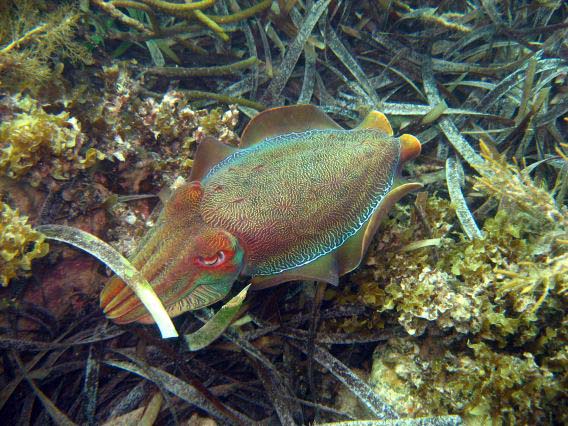
|
Search JoyZine with Google Site Search! |
|
Australian Giant Cuttlefish
Sepia apama, also known as the giant cuttlefish and Australian giant cuttlefish, is the world's largest cuttlefish species, with the mantle growing to half a metre, while total length can reach up to one metre, and over 10.5kg (23lb) in weight. The species can be identified by two rows of three skin flap-like papillae over each eye. The outer cone is wide and flared in the adult. The Australian giant cuttlefish is endemic to the southern coastal waters of Australia. It is found as far north as Moreton Bay, Queensland on the east-coast and Ningaloo Reef in Western Australia. This is a neritic species that occurs in a variety of habitats including: coral reefs, rocky reefs, seagrass beds and muddy and sandy areas.Regional differences between male colour patterns suggest there may be distinct populations or subspecies (Norman 2003). Individuals from the east and southern coast show both genetic and morphological differences that suggest previous isolation and subsequent secondary contact to form a continuous distribution (Reid et al. 2005). It has been suggested that the Spencer Gulf population may represent a separate species (Bronwyn Gillanders pers. comm. 2010). They are mainly active during the day using their excellent camouflage to hide. Colour patterns also play an important part in communication, particularly in the breeding season. Using cells known as chromatophores they can change colour in an instant, and by raising parts of their skin they can also change shape and texture to imitate rock, sand or seaweed. These displays have various interpretations to other marine creatures and may be used for camouflage, mating or even hypnotising prey. During breeding season, banner-like webs along the margins of the males' arms are flared to make individuals seem larger, to both appear a more attractive mate to females and to intimidate potential rivals. Ritualized visual displays are observed, with pulsating zebra stripes moving along the sides of the body, their speed and intensity changing with the situation. Mating takes place head to head, and spermatophores, or small packages of sperm, are passed from the male into an area in the female where fertilisation takes place. Sepia apama spawn from April to September, with a peak spawning period of May-June. Spectacular mass spawning occurs in the Spencer Gulf, where thousands of Australian giant cuttlefish congregate in relatively small patches of rocky reefs. Shortly after fertilisation the female will lay between 100 and 300 lemon-shaped, leathery, white eggs in subtidal crevices at low temperatures (12°C). It is thought the low incubation temperatures needed are one of the potential limiting factors of this species' range. Unlike many other cephalopods, female cuttlefish do not guard their eggs, which are left to hatch after 3-5 months. The distribution of this species may be restricted to cool southern waters because low temperatures reduce the problems associated with gas exchange in large eggs. The young develop directly. The Australian giant cuttlefish has a short life span of just two to four years. Many will show the teeth marks of dolphins, birds, and fish, which feed on both the living and dying animals. After spawning, many die. Mass extinctions are therefore commonly observed, with the cuttlebones of dead animals washed up onto beaches in large numbers. Sepia apama is taken as by-catch in trawl fisheries and on a small-scale, using jigs, baited hooks or spears. It is sold as food and bait. This species is collected as bycatch as well as by hook-and-line, and spear fisheries along the southern Australia coast. It has been actively targeted since the mid 1990s. The fishery in the Upper Spencer Gulf is of particular concern. There is also concern that smaller aggregations (such as that found at Wollongong) might be fished in the future. Ocean acidification caused by increased levels of carbon dioxide in the atmosphere is potentially a threat to all cuttlefish. Studies have shown that under high pCO2concentrations, cuttlefish actually lay down a denser cuttlebone, which is likely to negatively affect buoyancy regulation. in March-April S. apama embark on a pre-breeding feeding frenzy. They attack hooked fish and are detached with much difficult when brought to the surface. Within this period, they would appear to be extremely vulnerable to fishing. |
